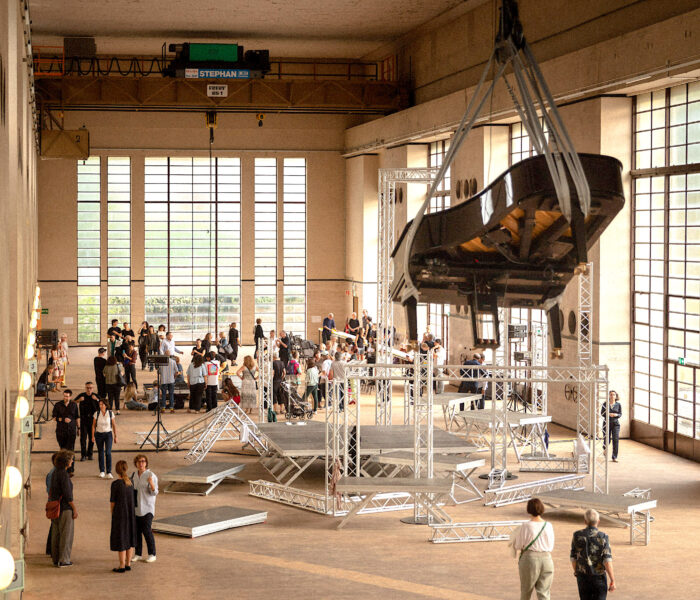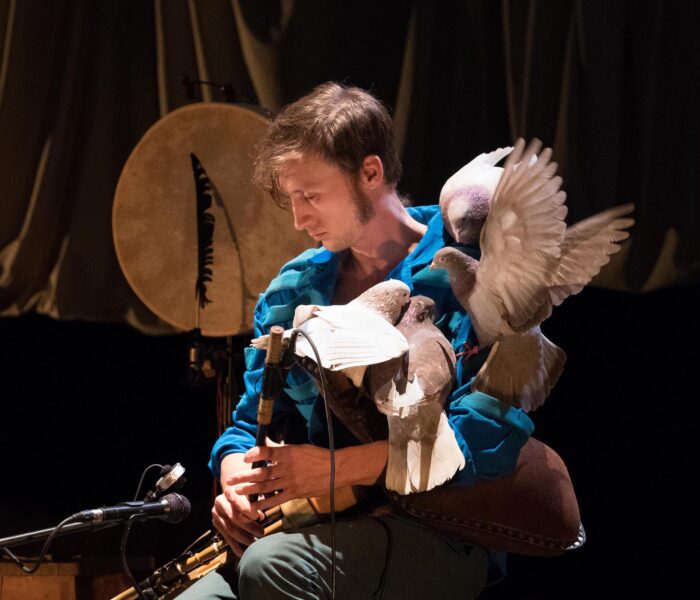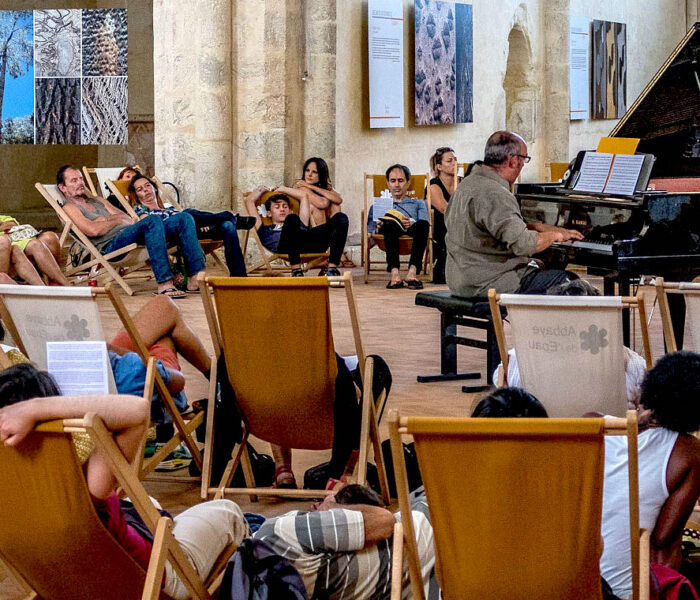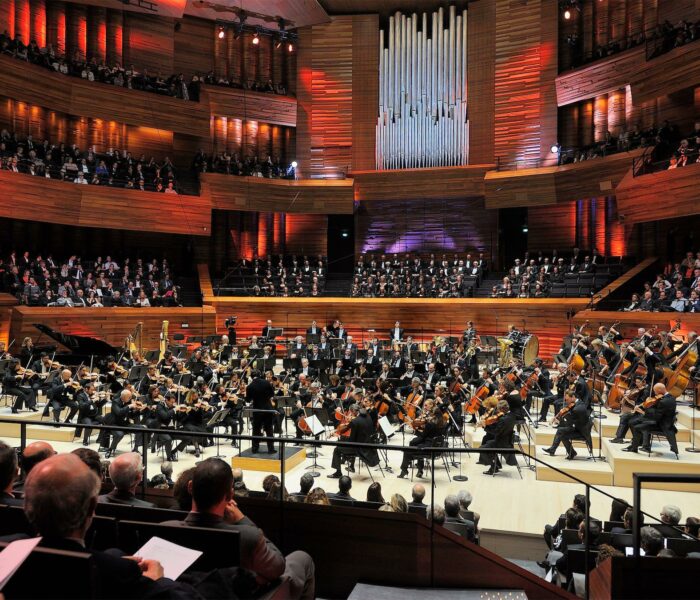Dans les années 1970, quelques artistes, issu.e.s du milieu de la musique, ont décidé de quitter l’espace de la scène pour investir d’autres espaces en créant de nouvelles formes nommées « site specific », ou encore installations / environnements sonores. Christina Kubisch appartient à cette première génération d’artistes sonores. Christophe Fellay, d’une autre génération, a amorcé au début des années 1990, le même virage. Quelles sont donc ces nouvelles formes, comment cela a-t-il transformé leur relation à l’écoute et au public?
Christina Kubisch, quelle est pour vous la place de l’instrumentiste dans l’art, la musique, la performance…?
Le rôle de l’instrumentiste a beaucoup évolué dans l’histoire de la musique. Il ne peut pas être défini de manière générale, car cela dépend de l’époque, du style musical, de la structure sociale du public, etc.
À Venise, au XVe siècle, l’instrumentiste était le chanteur, son instrument était la voix et il était censé savoir improviser avec elle. L’époque baroque a beaucoup utilisé l’improvisation dans les mélodies et les accompagnements. La période très classique de la musique occidentale était encore ouverte à différentes interprétations, mais moins “libres”. Puis dans la “nouvelle musique” du siècle dernier, et souvent jusqu’à aujourd’hui, l’instrumentiste n’est plus du tout libre, et l’on attend de lui qu’il joue des parties très difficiles, exactement telles qu’elles sont écrites.
Le compositeur est le roi, l’instrumentiste le serviteur.
La période où j’ai étudié la flûte dans les années 1960 et au début des années 1970 était souvent comme cela. Mais aujourd’hui, l'”instrumentiste” n’existe plus de manière traditionnelle, les jeunes musiciens prennent souvent part au processus de composition, travaillent avec les compositeurs et deviennent des partenaires de la création. Le terme “interprète-compositeur” est devenu normal et les compositeurs doivent respecter l’apport créatif de l’instrumentiste.
Christophe Fellay: L’instrumentiste d’aujourd’hui n’est plus simplement un interprète de haut vol pour la musique ou au service de l’art et de la performance, mais est avant tout un créateur qui cherche à faire évoluer sa relation avec l’instrument, à la recherche de nouvelles manières d’adresser son travail et du meilleur contexte possible pour le faire. Les frontières entre les différents domaines artistiques sont devenues poreuses au fil des dernières décennies et la place tout comme le rôle de l’instrumentiste dans l’art, la musique ou la performance est en pleine mutationJe m’intéresse au statut donné à l’instrument et à la possibilité de le considérer pour lui-même, pour ses propriétés et les sonorités qui pourraient en émaner avant qu’aucun son ne soit produit. Il s’agit d’une stratégie d’approche par le silence, en considérant les qualités sculpturales des instruments, à la recherche d’un potentiel sonore inédit dans ce qui pourrait être compris comme une sorte de préambule à la pratique instrumentale. Dans ma propre démarche j’ai été inspiré par les travaux d’artistes comme Max Neuhaus, Maryanne Amacher ou Pauline Oliveros qui à un moment donné ont questionné leur démarche instrumentale ou compositionnelle en dehors de toute intentionnalité musicale, souvent en dehors du champ de la musique. Cela m’a amené depuis plusieurs années à m’intéresser aux recherches théoriques et pratiques sur le rapport entre l’humain et le non-humain qui montrent que les objets, et par extension les instruments, ne sont ni passifs ni inertes, et qu’ils ne sont pas non plus simplement à la disposition des instrumentistes pour être utilisés/abordés selon notre unique volonté.
Comme beaucoup de créateurs sonores, j’ai longtemps travaillé à partir de ce que veut le son avant d’étendre cette question à ma relation avec les instruments.
Dans votre parcours, à quel moment cette place est-elle devenue un questionnement ?
CK: J’ai commencé la série Emergency solos en 1974, où j’ai remis en question le rôle classique d’une flûtiste féminine en réalisant une série de performances où je jouais de la flûte avec des dés à coudre en métal, des gants de boxe et des préservatifs, par exemple. À l’époque, certains critiques de musique traditionnelle ont dit que je jouais ces pièces uniquement parce que je n’étais pas capable d’interpréter des partitions difficiles de musique nouvelle, mais en fait cela ne m’intéressait plus car il n’y avait pas de participation créative dans le processus d’interprétation.
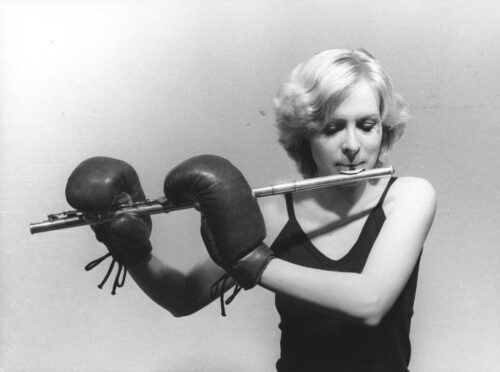
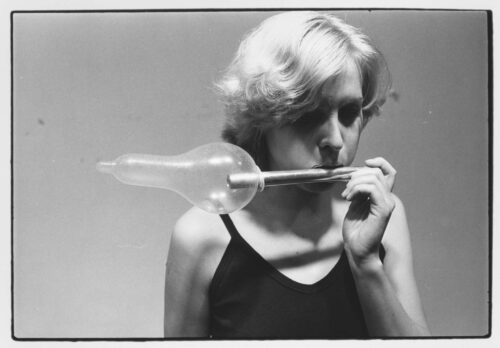
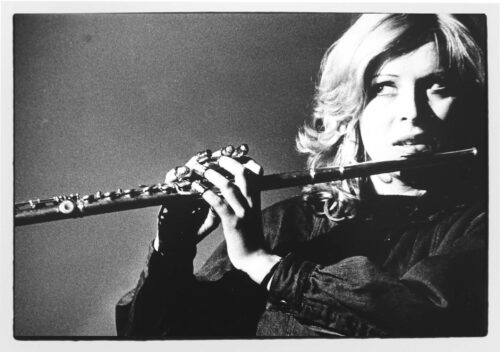
CF: À partir du milieu des années 1990, je me suis intéressé à développer des stratégies pour aller au-delà d’une certaine virtuosité instrumentale. J’ai commencé à m’intéresser aux sons et aux sonorités issues de mon instrument – la batterie – en travaillant à l’élaboration d’écosystèmes dynamiques au sein desquels je pouvais interagir avec lui d’égal à égal. Je me demandais comment les relations entre l’instrumentiste et son instrument pouvaient être redéfinies pour que les possibilités instrumentales et les capacités de l’interprète se co-déterminent mutuellement. Je me suis intéressé à ce que l’on pourrait nommer les « mondes cachés » des sons et des instruments, c’est-à-dire, le potentiel sonore présent, mais encore caché et à même d’être révélé lorsque l’instrument et l‘instrumentiste sont placés dans des réseaux de relations innovants. Ces différents réseaux de relations devaient être capables d’étendre mes capacités à affecter et à être affecté, dans une approche moins anthropocentrique de l’instrument. Au lieu de chercher son contrôle absolu, j’avais envie de me laisser guider et d’apprendre de mon instrument, de me laisser façonner par lui.
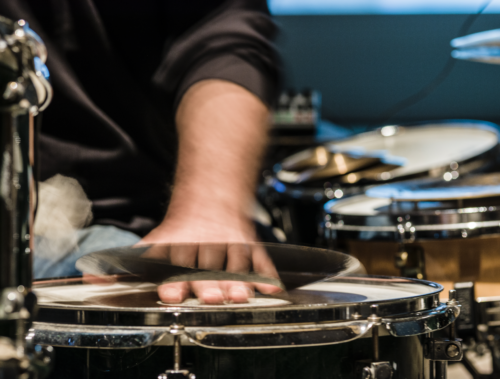
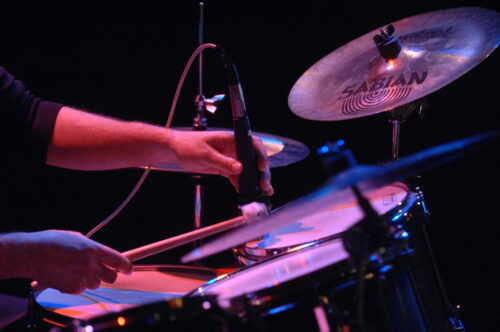
Comment ce questionnement a-t-il suscité chez vous la création de nouvelles formes ?
CK: Au début des années 1970, j’ai étudié au conservatoire de Zurich, mais j’ai également assisté à des cours d’ethnologie musicale à l’université locale. J’ai été impressionné par le fait que la musique pouvait faire partie de la vie quotidienne sans être un spectacle spécial sur une scène. Durant cette décennie, de nombreux compositeurs et musiciens se sont rendus en Afrique, en Inde et dans d’autres pays non occidentaux pour écouter et éventuellement jouer avec des musiciens locaux. Il n’y avait pas d’internet, pas d’ordinateur, il fallait donc voyager et vivre l’expérience directement. Pour ma part, je voulais créer une nouvelle forme d’écoute, individuelle et hors des salles de concert habituelles. Dans les années 1970 et 1980, il y avait beaucoup de petits festivals qui offraient des lieux de création excitants et inhabituels. L’expression “installation sonore” n’existait pas au début, mais l’importance d’un espace d’écoute spécifique faisait partie de la recherche de nombreux jeunes musiciens/compositeurs/instrumentistes.
CF: En tant que batteur, je me suis mis littéralement à l’écoute de mon instrument via l’utilisation d’un microphone mobile (tenu à la main) en guise d’oreille microscopique et qui, pas à pas, s’est transformé en baguette virtuelle. L’extension de ce travail dans des enceintes amplifiées a ouvert la voie à un déplacement spatial du son de mon instrument vers le haut-parleur et a initié une recherche à la fois sur les sonorités et les trois espaces complémentaires qui m’accompagnent depuis dans la plupart de mes œuvres : l’espace physique, l’espace virtuel et l’espace mental.
J’avais l’intuition que pour laisser la parole à mon instrument, il fallait laisser aux sons le temps d’être eux-mêmes. La batterie ne possède pas de pédale de soutien – comme le piano ou le vibraphone, par exemple – et l’action du batteur est nécessaire pour le maintien et l’évolution du son dans la durée, ce qui, dans mon approche, posait un certain nombre de questions. Travailler sur les durées m’a permis de créer des performances et des installations sonores immersives qui utilisent le temps long et la lenteur. Je m’intéresse aussi aux frontières de la perception comme le battement qui devient fréquence sonore et vice-versa
Enfant, je jouais du tambour, avec l’ensemble que dirigeait mon père, en marchant lors de parades dans les vallées et les villages alpins, ce qui est une expérience tout à fait singulière : la quantité, la qualité et la durée des échos varie d’une manière significative et permanente. Le contexte agit directement sur les sons, avec des effets de filtrage, d’amplification, d’écho et de réverbération. Partant de ce souvenir, j’ai travaillé à l’élaboration de performances spatialisées au sein desquelles le public est invité à circuler librement. Pour mes performances ou installations sonores je passe de l’exploration d’espaces résonnants, comme des halles industrielles ou des édifices religieux, à des environnements plus complexes et l’utilisation d’espaces architecturaux comme caisses de résonance.
Je travaille en ce moment sur les espaces réels, virtuels et imaginaires au sein d’un projet collaboratif entre l’Europe et l’Afrique du Sud qui s’appelle Listening At The Edge. Le projet L.A.T.E. est une démarche participative qui explore par l’écoute les différents limites, bordures, contours entre nos disciplines, origines, lieux de vie, contextes de création, etc… Écouter, improviser, créer et réagir les uns aux autres et à la pluralité des contextes constituent la base de cette exploration. Nous cherchons à étendre les contributions des membres du collectif entre les disciplines, mais aussi géographiquement en prolongeant les espaces de création à distance.
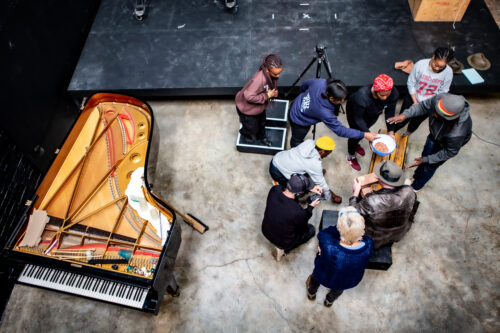
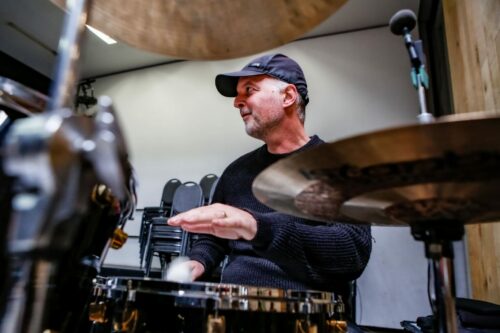
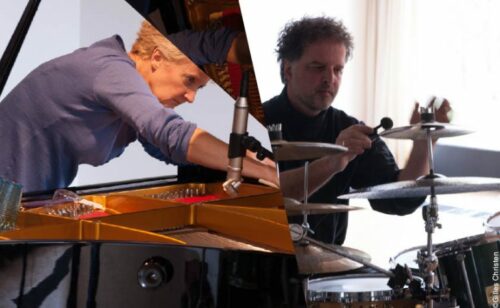
En quoi ces nouvelles formes que vous avez chacun créées, expérimentées interrogent-elles la question de place de l’écoute, de celle du public?
CK: J’aime créer des espaces où les gens peuvent choisir où, comment et pendant combien de temps ils veulent écouter (de la musique ?). Ils peuvent rester une heure au même endroit ou changer rapidement de position et se déplacer dans le lieu de l’installation en dix minutes. Il s’agit simplement d’une situation où l’on peut commencer à écouter aussi longtemps que l’on veut et partir ensuite.
Créer un environnement sonore est un processus bien différent de celui mis en œuvre dans une performance de 20 minutes avec un début, un développement et une fin très précise. J’aime aussi “la musique de scène structurée”, mais je m’intéresse davantage à d’autres formes de composition et surtout aux installations spécifiques à un site.
Christina Kubisch – Electrical Walks. An introduction to Christina Kubisch's "Electrical Walks" series of works from Christina Kubisch on Vimeo.
CF: Toute forme de création sonore et/ou musicale fait appel à l’écoute à des degrés divers mais dans une telle approche centrée sur le son, elle peut être considérée comme un paramètre vital. En tant que créateur, ma posture est avant tout celle de l’auditeur et la question de l’écoute est à la source de l’essentiel de mes travaux. Dans la plupart de mes créations, je travaille à partir d’une pratique particulière de l’écoute qui suggère un mouvement qui commence par l’attention portée au détail pour aboutir à la forme. Je n’ai de cesse d’interroger l’écoute comme un outil de création, même lorsqu’une forme de non-écoute peut être utile pour permettre aux sons de se développer selon leur propre temporalité. Cette nécessaire distanciation par rapport à une écoute trop réactive favorise la découverte et ouvre la voie à une approche moins anthropocentrique de mon travail.
J’aime à penser que les types de processus que je mets en œuvre, axés sur le son, le rythme, le mouvement, l’architecture, peuvent être abordés comme des phénomènes liés à l’énergie : si les sons nous touchent ou touchent l’auditeur, ce n’est pas parce que nous les comprenons, mais parce que nous sommes entraînés par des formes de transformations auxquelles nous (auditeurs) participons activement. Cela offre à l’auditeur l’opportunité de co-construire un imaginaire sonore, de prendre le temps de créer des associations et de donner aux souvenirs et aux expériences passées la possibilité de refaire surface.
Pouvez-vous nous donner un exemple de ces formes de composition ou installations spécifiques à un lieu que vous avez réalisé dernièrement ?
CK: Mes installations sont très souvent spécifiques à un site. Cela signifie qu’elles ne peuvent être réalisées qu’une seule fois parce qu’elles sont conçues pour un lieu particulier, son architecture, son atmosphère, son histoire, ses caractéristiques acoustiques, etc. L’une des plus grandes œuvres a été Licht Himmel, une commande pour le Gasometer à Oberhausen, un ancien réservoir de gaz dans la région allemande de la Ruhr. J’ai utilisé des lumières spéciales et développé un environnement sonore de 14 canaux pour l’énorme tour métallique de près de 100 mètres de haut. J’ai dû me rendre plusieurs fois sur place pour faire des essais avec la lumière et le son, car aucune simulation informatique n’était satisfaisante en raison de l’architecture et de l’environnement particuliers. La peau métallique de la tour semblait solide, mais tous les bruits provenant de l’extérieur (vent, pluie, circulation, trains, voitures, voies ferrées, etc.) produisaient des sons qui pénétraient à l’intérieur et devenaient partie intégrante de l’installation sonore.
J’ai dû travailler avec mes propres sons et m’adapter aux éléments imprévisibles de l’extérieur. On pouvait entendre la composition en entrant dans l’espace et en montant par un ascenseur jusqu’au sommet d’une plateforme. L’écoute et l’aspect visuel varient en fonction de la position du visiteur, du temps, de la position d’écoute à l’intérieur du gazomètre et du temps qu’une personne était prête à rester (la durée totale de la composition était de 120 minutes).

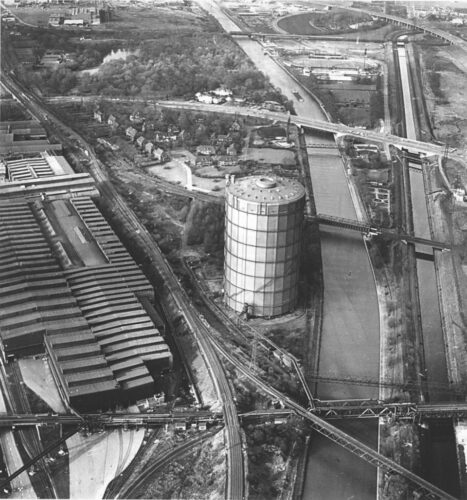
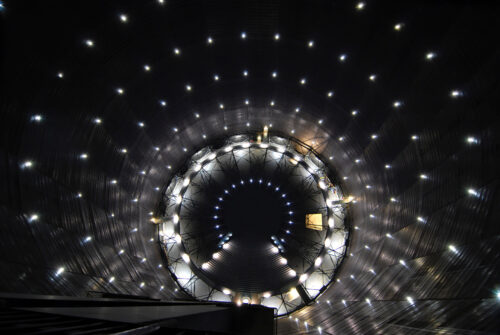
D’autres installations peuvent voyager, mais bien que la structure de base soit fixe, elles sont toujours installées en relation avec un espace donné. La couleur du câble électrique, les séquences sonores, la structure porteuse ou le nombre de canaux peuvent changer, mais le caractère général de l’œuvre demeure. Les œuvres de ce type sont par exemple La Serra, qui a débuté en 2017, ou Weaving, en cours depuis 2018.
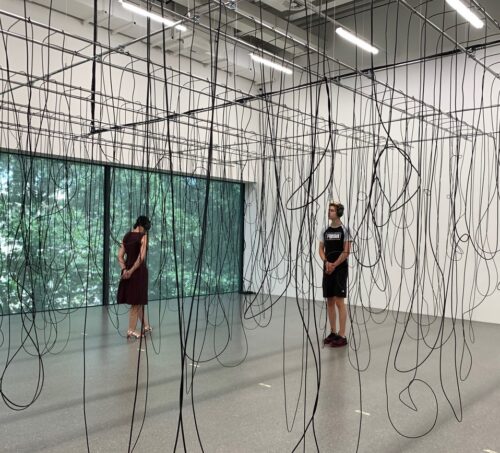
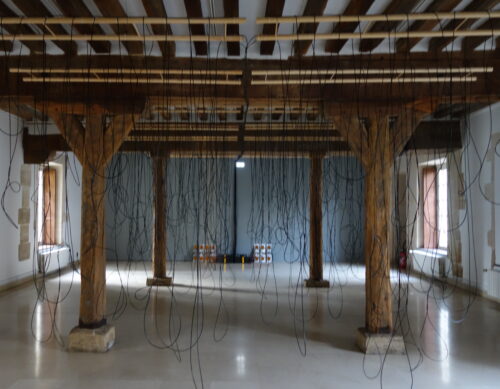

CF: J’ai créé récemment, en collaboration avec le MUDAC de Lausanne et le CID Grand-Hornu en Belgique, une installation sonore qui s’appelle Signatures sonores #1 (2022) qui met en relation le visiteur avec les propriétés cachées des objets. J’ai créé les signatures sonores de soixante-quatre objets de design libanais contemporains. Ces signatures ont été élaborées à partir de leur forme, des dimensions, du volume, de la qualité et de la densité des matériaux utilisés pour leur fabrication. Les fréquences fondamentales et harmoniques de chaque objet ont été modélisées, puis réalisées dans un laboratoire de musicologie numérique et cognitive, avant de servir de support-partition pour la création de l’œuvre. L’installation diffuse dans quarante-cinq haut-parleurs des espaces sonores structurés comme des éléments d’architecture que l’on peut traverser et dans lesquels les visiteurs et les objets cohabitent. Cette démarche s’est étendue aux objets/instruments qui composent ma batterie pour pièce qui se nomme UnFrozen (2023) dans le cadre d’une exposition au 601Artspace de New York.
Propos recueillis par Anne-Laure Chamboissier
Photos © Chris Morgan
Photos © Studio Edouard Curchod
Photos © Gilles Christen
Photos © Zivani Mutangi



)
